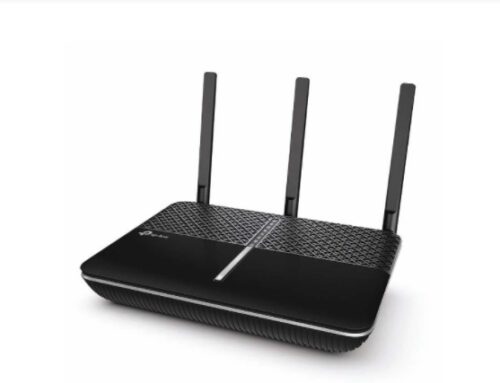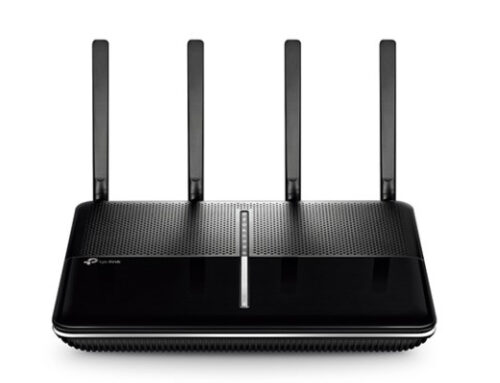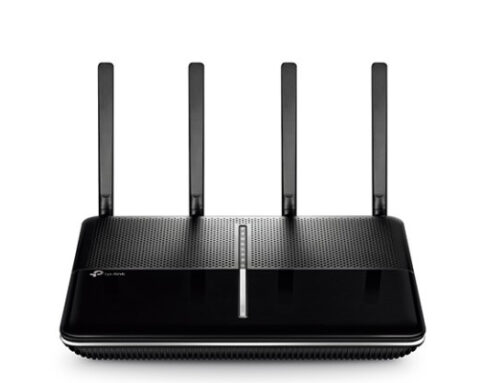The TP-Link Archer VR600v is an AC1600-class DSL modem router from the Shenzhen-based manufacturer, specifically created to cater to the needs of those budget-conscious people that require a decent wireless performance (nothing over the top though) together with an easy-to-use, intuitive user interface which should cover at least the most necessary features (like QoS, Parental Controls or Guest Access).
Fortunately, the TP-Link Archer VR600v should be able to deliver a decent wireless performance (although the AC1600-class does indicate that this modem router is not really the most powerful that TP-Link has to offer), it is compatible with a VDSL, ADSL, fiber or cable connection and as a welcomed bonus, the VR600v supports VoIP and telephone functions (which makes it a great addition to any small to medium businesses). If it wasn’t already obvious, the VR600v is actually the Archer VR600 second version equipped with built-in VoIP capabilities (hence, the small v at the end of the name).
Where To Buy TP Link Archer VR600 Router:
TP-Link Archer VR600 Reviews: Design
The incredible success of the WiFi systems is in part because of their ability to uniformly cover a larger area, but also due to the minimalist design approach which stripped the external antennas and adopted a neutral look. So it’s clear that the traditional router needs to become less aggressive and more living-room friendly since these small networking devices are now a necessary part of almost all homes (this means that the manufacturers can no longer cater only to the enthusiasts). But TP-Link isn’t really known to create provocative-looking routers and besides the arachnoid-looking Talon AD7200 (which was still less ominous than the Asus gaming routers series), the TP-Link routers are always more discreet.
And that is also the case with the Archer VR600v which, despite its three external antennas, it still manages to be elegant and it won’t look out-of-place on the coffee table. You would be surprised to know that this is actually a two-year old design which is now quite common among TP-Link’s modem router series (including the original v1 VR600), but since it has aged so well, it was also ported to some of its wireless routers series (such as the Archer C2300 or Archer C2600). That being said, the TP-Link Archer VR600v features a rectangular case with rounded corners and the main attraction is the top area which is half covered by a glossy finish (which does retain fingerprints), while the other half is covered by a matte finish and has lots of small ventilation holes (that slightly expose the internal hardware).
TP-Link did took seriously the proper heating management so, on the bottom area, the case is almost completely covered by small ventilation cut-outs and, in-between the top and the bottom side, there’s a small canal where TP-Link has also positioned additional vent holes. In this manner, the case seems to have a good heat management, but, I did notice that the router runs a bit warm and, on the bottom, there were hotter spots (and this has proven to be true during my test, especially while putting the device under a lot of stress). While not as compact and small as the recent WiFi mesh nodes, the TP-Link Archer VR600v is still among the smaller routers, measuring 8.49 x 6.44 x 1.44 inches and weighing 1.01 lbs, so it can be easily placed on a shelf or on the desk, but, if you don’t have much space to spare, then you can mount the router on the wall using the two holes from the rear side.
On top of the device, the case is cut vertically in two by a narrow area, half of it being home to the LED indicators and half acting as a LED On/Off button. The array of LED lights show the status of the Power (flashing indicates that either the system is booting up or the firmware is upgraded), DSL (on indicates that the sync was successful, off signifies that the sync has failed and the flashing LED indicates that the sync is in progress), Internet, the 2.4 GHz radio, the 5GHz radio (flashing indicates that the WPS pairing is in progress), LAN (it is a global LED, so even if one LAN port is connected, it will be turned on– I would have preferred individual LEDs, but it still is better than the frustratingly minimalist single LED light on the mesh systems), USB (flashing indicates that it tries to identify the connected device) and Phone (if the LED is on, then either the DECT phone is busy or the phone is off-hook and it will flash when the phone is ringing or when the DECT phone is registering).
On the rear side, you will be able to find all the connectors and ports: from the left, there are two RJ11 ports for linking a couple of analogue phones, one DSL port, a USB 2.0 port (suitable for connecting the router to a printer– although the USB 3.0 should be the standard by now), three Gigabit Ethernet LAN ports and one LAN4/WAN Gigabit Ethernet port (if you are using the device in wireless router mode, then you can use the LAN4/WAN port to connect to the modem), together with a Power port and three connectors for the omni-directional removable antennas.
On the left side of the modem router, you can find a Power On/Off button, a recessed Reset button (use a paperclip to hold it for 10 seconds so as to return the device to factory default settings), a WPS button, a WiFi On/Off switch and a DECT button (to register a DECT handset, press and hold the button for 2 seconds until the Phone LED flashes).
TP-Link Archer VR600 Reviews: Hardware
Inside the case, TP-Link has equipped the TP-Link Archer VR600v modem router with a Broadcom BCM63168 chipset and 128 MB of RAM. However, I couldn’t get more info since I found it impossible to open the case without risking breaking it even after removing the screws (TP-Link has put some seriously stubborn clips).
Note: The TP-Link Archer VR600v is marketed as an AC1600-class router, so the maximum theoretical data transfer rate is 1,300 Mbps using the 5GHz radio band and a maximum theoretical data transfer rate of 300 Mbps using the 2.4 GHz.
TP-Link Archer VR600 Reviews: Performance
Because the TP-Link VR600v is a low-cost device, it will only have a few features to improve wireless performance. The most notable of these is Advanced BeamForming, which has the function of directing the signal directly towards the clients who are connected via WiFi rather than broadcasting it throughout the entire network (be aware that to take advantage of this technology, the wirelessly connected clients need to have compatible WiFi adapters). Because of this, if you want the MU-MIMO technology (which is only beneficial if you can obtain devices with high-end WiFi adapters), the NitroQAM (1024QAM) technology, or the 160MHz Aggregation, you should choose the more expensive TP-Link VR2800v router.
In addition, the TP-Link Archer VR600v will not be able to function as a node within a mesh network; and even if TP-Link decides to develop something similar to the AiMesh technology, it will not be compatible; therefore, if you have a large home and require a mesh system, you can use the TP-Link Archer VR600v in modem mode only (to do so, go to the Network > Internet tab > Add > Connection Type > Bridge and afterward, disable the DHCP as well This way, you’ll be able to install any other WiFi mesh system you like, and if you’re a fan of the TP-Link environment, you could try out the dual-band Deco M5 or wait a little longer and check out the newer tri-band Deco M9, which is now in beta testing.
But, the TP-Link Archer VR600v is more than just a wireless router and DSL modem; it also has VoIP compatibility built-in, allowing you to connect two analog handsets and up to six cordless phones or fax machines to the network through the accompanying DECT station (additionally, it comes with 270 minutes Voice Mail). While away from home, you may connect any smartphone to the modem router and make landline calls, check messages and missed phone calls, and browse your PhoneBook contacts. The TP-Link Archer VR600v also can connect any smartphone to the modem router.
3G/ 4G Router Mode and Wireless Router Mode are the three operational modes supported by the TP-Link VR600v. The first of these is VDSL/ ADSL modem router mode, the second is 3G/ 4G router mode, and the third is the Wireless Router mode.
TP-Link Archer VR600 Reviews: Conclusion
I know that 2018 remains the year of WiFi mesh systems, but the TP-Link Archer VR600v came as a surprise on many fronts: the wireless performance on the 5GHz WiFi network was way above average considering its price tag (at the same time, the performance on the 2.4 GHz WiFi network was underwhelming) and the web-based user interface will satisfy the tech-savvy people, while the Tether app should be enough for people that don’t really care for an in-depth configuration. Obviously, it has its flaws, like the aforementioned 2.4 GHz performance, the slight overheating problem and the lack of a USB 3.0, but all of these don’t outweigh the positive points, so the Archer VR600v remains a great budget-friendly solution for small-to-medium homes which are still stuck to the DSL lines.











Leave A Comment